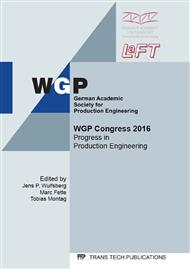[1]
Rummenhöller, S. (1996): Werkstofforientierte Prozessauslegung für das Fräsen kohlenstoffaserverstärkter Kunststoffe. Techn. Hochsch., Diss. -Aachen, 1996. Als Ms. gedr. Aachen: Shaker (Berichte aus der Produktionstechnik, 96, 8).
Google Scholar
[2]
Biermann, D.; Hufenbach, W.; Seliger, G. (2008).
Google Scholar
[3]
Mitschang, P. (2014): Fertigteilbearbeitung. In: AVK – Industrievereinigung Verstärkte Kunststoffe e. V. (Hg. ): Handbuch Faserverbundkunststoffe. Grundlagen, Verarbeitung, Anwendungen; mit 46 Tabellen. Wiesbaden: Springer Vieweg, S. 509–521.
DOI: 10.1007/978-3-8348-9355-0_2
Google Scholar
[4]
Wang, X.; Kwon, P.; Sturtevant, C.; Kim, D.; Lantrip, J. (2014): Comparative tool wear study based on drilling experiments on CFRP/Ti stack and its individual layers. In: Wear 317 (1-2), S. 265–276. DOI: 10. 1016/j. wear. 2014. 05. 007.
DOI: 10.1016/j.wear.2014.05.007
Google Scholar
[5]
Wang, X.; Kwon, P.; Sturtevant, C.; Kim, D.; Lantrip, J. (2013): Tool wear of coated drills in drilling CFRP. In: Journal of Manufacturing Processes 15 (1), S. 127–135. DOI: 10. 1016/j. jmapro. 2012. 09. 019.
DOI: 10.1016/j.jmapro.2012.09.019
Google Scholar
[6]
Faraz, A. (2011): Experimental study on delamination, mechanical loads and tool wear in drilling of woven composite laminates. Dissertation, Vulkan-Verl., Essen.
Google Scholar
[7]
Walter, A. et. al. (2012).
Google Scholar
[8]
Selzer, R.; Friedrich, K. (1995): Inluence of water up-take on interlaminar fracture properties of carbon fiber-reinforced polymer composites. In: JOURNAL OF MATERIALS SCIENCE 30 (2), S. 334–338. DOI: 10. 1007/BF00354392.
DOI: 10.1007/bf00354392
Google Scholar
[9]
Fröhlich, B. (2010): Einfluss von Minimalmengenschmierung auf Werkzeugstandweg und Zerspantemperatur beim Hochgeschwindigkeitsschlichtfräsen von gehärtetem Werkzeugstahl. Aachen: Shaker (Innovation Fertigungstechnik, ).
Google Scholar
[10]
Hänle, P. (2010).
Google Scholar
[11]
Boese, H. (1986): Beitrag zur Zerspanung verstärkter Kunststoffe unter dem gezielten Einsatz von Kühlschmierstoffen. Techn. Univ., Diss. -Clausthal, 1986. Clausthal: TU.
Google Scholar
[12]
Habig, K.; Mang, T. (2015): Schmierstoffe. In: Czichos, H. und Habig, K. (Hg. ): Tribologie-Handbuch. Tribometrie, Tribomaterialien, Tribotechnik. 4., vollst. überarb. u. erw. Aufl. Wiesbaden: Springer Fachmedien Wiesbaden, S. 417–440.
DOI: 10.1007/978-3-8348-2236-9_10
Google Scholar
[13]
Birkhofer, H.; Kümmerle, T. (2012): Feststoffgeschmierte Wälzlager. Einsatz, Grundlagen und Auslegung. Berlin: Springer Vieweg (VDI-Buch).
DOI: 10.1007/978-3-642-16797-3_5
Google Scholar
[14]
Suresh Kumar Reddy, N.; Venkateswara Rao, P., 2006. Experimental investigation to study the effect of solid lubricants on cutting forces and surface quality in end milling. International Journal of Machine Tools & Manufacture 46 (2006) 189–198.
DOI: 10.1016/j.ijmachtools.2005.04.008
Google Scholar
[15]
Nageswara Rao, D.; Vamsi Krishna, P. (2008).
Google Scholar


